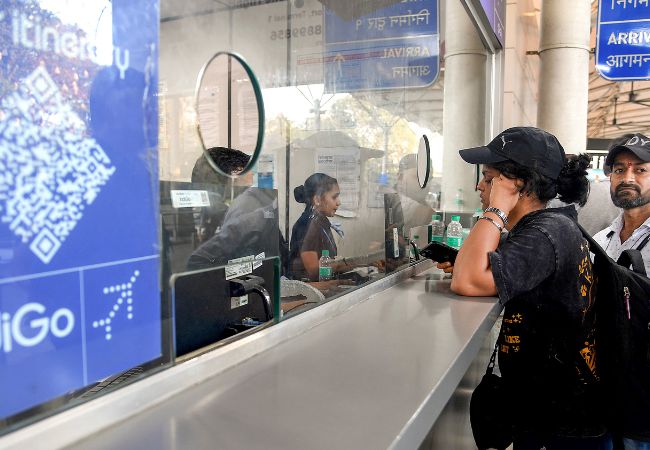Tokyo: Indian shuttlers P V Sindhu and B Sai Praneeth moved into the quarterfinals of the Japan Open after registering contrasting wins in their respective events here on Thursday.
While fifth seed Sindhu had to toil hard in an hour-long battle to get the better of unseeded Japanese Aya Ohori 11-21 21-10 21-13 in a second round women's singles match, Praneeth sailed past another local shuttler, Kanta Tsuneyama, 21-13 21-16 in a men's singles encounter that lasted 45 minutes.
However, H S Prannoy, who knocked out compatriot Kidambi Srikanth in the opening round, went down to Rasmus Gemke of Denmark 9-21 15-21 in his second round match.
The win at the BWF World Tour Super 750 tournament on Thursday extended Sindhu's head-to-head record to 8-0 over Ohori.
Sindhu will next face the winner of the match between China's Chen Xiao Xin and fourth seeded Japanese Akane Yamaguchi, to whom she lost in the final of the Indonesia Open last week.
Sai Praneeth, on the other hand, will face Indonesia's Tommy Sugiarto in the men's singles last-eight round.
It was good news for India in the men's doubles event as the pair of Satwiksairaj Rankireddy and Chirag Shetty made it to the quarterfinals after emerging victorious in a tough three-game second round affair in 53 minutes.
The Indian pair came from a game down to quell the challenge of China's Kai Xiang Huang and Cheng Liu 15-21 21-11 21-19 and set up a quarterfinal clash with second seeded local combination of Takeshi Kamura and Keigo Sonoda.
In the match between Sindhu and Ohori, the Rio Olympics silver medallist Indian shuttler was slow to get off the blocks as the local girl came out on top in the early exchanges to race to a 5-1 and then 11-5 lead at the break.
Sindhu took it easy in the first game and the approach acted in Ohori's favour as the Indian committed a lot of unforced errors.
An error-prone Sindhu never looked in the contest as she kept of hitting the shuttle at the net or outside the court that enabled Ohori to pocket the first game rather comfortably.
In the second game too Sindhu struggled initially before getting her acts together just on time. Trailing 0-2, the Indian made a great comeback to draw level and then took the lead for the first time in the contest.
Once she managed to take a 3-2 lead, there was no looking back for Sindhu and she kept on extending her domination to grab the second game and roar back into the contest.
Sindhu continued in the same vein in the decider and surged ahead 3-1 and then 8-4 before Ohori clinched four straight points to level the scores at 8 apiece.
But just when she felt threatening, Sindhu lifted her game and won six consecutive points to take 14-8 lead. From there on, Sindhu didn't look back and kept her nose ahead to pocket the third game and seal her quarterfinal berth.
Let the Truth be known. If you read VB and like VB, please be a VB Supporter and Help us deliver the Truth to one and all.
Colombo (PTI): A mobile hospital set up by India in Sri Lanka has provided medical care to over 2,200 people affected by Cyclone Ditwah, as New Delhi ramped up its assistance to the flood-ravaged island nation with engineering support and delivery of fresh relief consignments, the Indian mission here said on Sunday.
Sri Lanka has been grappling with widespread flooding, landslides and severe infrastructure collapse triggered by the cyclone, leaving several districts isolated and severely straining the country's disaster-response capacity.
At least 627 people have been killed and 190 remain missing as of Sunday noon due to catastrophic floods and landslides caused by extreme weather conditions since November 16.
Sharing a social media post by the Ministry of External Affairs on its X handle, the Indian High Commission said a field hospital set up by India in Mahiyanganaya near Kandy has provided medical care to more than 2,200 people affected by the cyclone since December 5.
The hospital has also performed 67 minor procedures and three surgeries, it said. The field hospital was airlifted to Sri Lanka by an IAF C-17 aircraft along with a 78-member Indian medical team on Tuesday.
In another post, the mission said Indian Army engineers, working with Sri Lanka Army Engineers and the Road Development Authority, in Kilinochchi have begun removing a damaged bridge on the Paranthan–Karachchi–Mullaitivu (A35) road, a key route disrupted by the cyclone.
"This joint effort marks another step toward restoring vital connectivity for affected communities," it said.
India has additionally sent nearly 1,000 tonnes of food items and clothing contributed by the people of Tamil Nadu. Of these, about 300 tonnes reached Colombo on Sunday morning aboard three Indian Naval ships.
High Commissioner Santosh Jha handed over the supplies to Sri Lankan Minister for Trade, Commerce, Food Security and Cooperative Development Wasantha Samarasinghe.
India, on November 28, launched 'Operation Sagar Bandhu', a Humanitarian Assistance and Disaster Relief (HADR) initiative, to aid Sri Lanka in its recovery from the devastation caused by Cyclone Ditwah.
Since the launch of the operation, India has provided about 58 tonnes of relief material, including dry rations, tents, tarpaulins, hygiene kits, essential cloths, water purification kits and about 4.5 tonnes of medicines and surgical equipment, the Indian mission said in a press release on Sunday.
Another 60 tonnes of equipment, including generators, inflatable rescue boats, Outboard Motors, and excavators, have also been brought to Sri Lanka, it said, adding that 185 tonnes of Bailey Bridge units were airlifted to restore critical connectivity along with 44 engineers.
Two columns of the National Disaster Response Force, comprising 80 experts and K9 units with specially trained dogs, assisted with immediate rescue and relief efforts in Sri Lanka.
Besides the field hospital in Mahiyanganaya, medical centres have also been set up in the badly hit Ja-Ela region and in Negombo. INS Vikrant, INS Udaygiri, and INS Sukanya provided immediate rescue and relief assistance to Sri Lanka.
Apart from the two Chetak helicopters deployed from INS Vikrant, two heavy-lift, MI-17 helicopters of the Indian Air Force are actively involved in evacuations and airlifting relief material, the release said.
At the request of the Sri Lankan Disaster Management Centre, a virtual meeting was organised between DMC and the Indian Space Research Organisation (ISRO)'s National Remote Sensing Centre on Saturday.
Since the onset of the disaster, ISRO has been providing maps to assist DMC in its rescue efforts, the release said.





